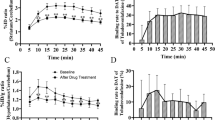Abstract.
The recently developed radioligand [123I]FP-CIT is suitable for clinical single-photon emission tomography (SPET) imaging of the dopamine (DA) transporter in vivo. To date it has remained unclear whether dopaminergic medication influences the striatal [123I]FP-CIT binding. The purpose of this study was to investigate the influence of this medication on [123I]FP-CIT binding in the brain. We used an animal model in which we administered dopaminomimetics, antipsychotics and an antidepressant. In vivo [123I]FP-CIT binding to the DA and serotonin transporters was evaluated after sub-chronic and acute administration of the drugs. The administered medication induced small changes in striatal [123I]FP-CIT binding which were not statistically significant. As expected, the DA reuptake blocker GBR 12,909 induced a significant decrease in [123I]FP-CIT binding. [123I]FP-CIT binding in the serotonin-rich hypothalamus was decreased only after acute administration of fluvoxamine. The results of this study suggest that dopaminergic medication will not affect the results of DA transporter SPET imaging with [123I]FP-CIT.
Similar content being viewed by others
Author information
Authors and Affiliations
Additional information
Received 15 August and in revised form 15 October 1999
Rights and permissions
About this article
Cite this article
Lavalaye, J., Knol, R., de Bruin, K. et al. [123I]FP-CIT binding in rat brain after acute and sub-chronic administration of dopaminergic medication. Eur J Nucl Med 27, 346–349 (2000). https://doi.org/10.1007/s002590050044
Issue Date:
DOI: https://doi.org/10.1007/s002590050044




